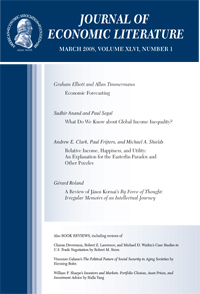两全其美:结合随机对照试验和结构模型
IF 11.5
1区 经济学
Q1 ECONOMICS
引用次数: 13
摘要
关于经济理论应在多大程度上为计量经济学建模和估计提供信息,存在着长期的争论。这种争论在项目/政策评估文献中尤为明显,在这些文献中,简化形式(实验或准实验)和结构建模方法通常被视为竞争方法。简化形式的支持者批评结构应用程序中引用的假设。结构建模倡导者指出,简化形式方法的局限性在于,无法在实施前告知项目影响,也无法告知偏离实施方案的项目设计的成本和收益。在本文中,我们认为,这两种方法之间存在着一种新的自然协同作用,即可以将它们融合在一起,以利用各自的优势并改善其劣势。我们提供了来自随机对照试验(RCT)的数据的例子,这些数据是简化形式从业者的典范,可以用来提高结构估计的可信度。我们还说明了结构方法如何通过对反事实政策/计划进行评估来补充实验分析。最后,我们调查了最近的许多研究,这些研究以各种方式将这些方法结合在经济学的不同子领域。(JEL C21、C52、C53、H24、I38、J13、R38)本文章由计算机程序翻译,如有差异,请以英文原文为准。
The Best of Both Worlds: Combining Randomized Controlled Trials with Structural Modeling
There is a long-standing debate about the extent to which economic theory should inform econometric modeling and estimation. This debate is particularly evident in the program/policy evaluation literature, where reduced-form (experimental or quasi-experimental) and structural modeling approaches are often viewed as rival methodologies. Reduced-form proponents criticize the assumptions invoked in structural applications. Structural modeling advocates point to the limitations of reduced-form approaches in not being able to inform about program impacts prior to implementation or about the costs and benefits of program designs that deviate from the one that was implemented. In this paper, we argue that there is a new emerging view of a natural synergy between these two approaches, that they can be melded to exploit the advantages and ameliorate the disadvantages of each. We provide examples of how data from randomized controlled trials (RCTs), the exemplar of reduced form practitioners, can be used to enhance the credibility of structural estimation. We also illustrate how the structural approach complements experimental analyses by enabling evaluation of counterfactual policies/programs. Lastly, we survey many recent studies that combine these methodologies in various ways across different subfields within economics. (JEL C21, C52, C53, H24, I38, J13, R38)
求助全文
通过发布文献求助,成功后即可免费获取论文全文。
去求助
来源期刊

Journal of Economic Literature
ECONOMICS-
CiteScore
17.80
自引率
0.80%
发文量
49
期刊介绍:
Commencing in 1969, the Journal of Economic Literature (JEL) serves as a vital resource for economists, offering a means to stay informed about the extensive literature in the field. Each JEL issue features commissioned, peer-reviewed survey and review articles, book reviews, an annotated bibliography categorizing new books by subject, and an annual index of dissertations from North American universities.
 求助内容:
求助内容: 应助结果提醒方式:
应助结果提醒方式:


